| |
| Star Wars Super Models |
| |
| Star Wars Super Models |
| Film Relied on Innovative Modeling Techniques to Create
the Digital Stars, Pods, Props, and Sets of Episode I: The Phantom menace |
| By Barbara Robertson |
| There`s at least one thing everyone who has seen Star Wars
Episode I: The Phantom Menace can agree with: This movie is filled with
digital visual effects. Indeed, most scenes include elements created at
Industrial Light & Magic (San Rafael, CA) with computer graphics tools--elements
as imposing as digital characters and space ships and as invisible as set
extensions. When you stop to think that each little bit of computer graphics
(with the exception of pure particles) had to be modeled, the sheer enormity
of this effort can`t fail to impress. "We created models that ranged in
size from as small as a mosquito to Fambaa [a huge animal], which is 30
feet tall," says Geoff Campbell, digital model supervisor. |
| The models fell into one of two categories, organic or
hard surface, each having its own methodology and requirements. Organic
models were used for principle characters such as Jar Jar, Watto, Sebulba,
and Boss Nass; secondary characters such as Yoda (when he`s walking around),
Jabba the Hutt, the two-headed pod-race announcer, pod-race drivers, several
varieties of animals and "fish;" plus many background characters. Hard-surface
models were used to create props that ranged in size and complexity from
saddles and reins to energy balls. Hard-surface models were also used for
droids, space ships, racing pods, the Gungan submarine, and for a few sets.
While most exterior shots used miniatures, CG models were used to extend
or create four interior sets: the Theed central hangar, the palace hallway,
the generator room, and the galactic center rotunda. Approximately 18 modelers
worked on the movie, according to Campbell. Some concentrated on one category,
but many worked on both types. |
| Shaping Characters |
| All told, the movie included 66 characters and creatures,
and for these organic models Campbell and his team used Softimage 3D, Alias
Power Animator, and ILM`s proprietary I Sculpt software running on SGI
workstations
to create and shape the basic mesh. For models relatively close to the
camera, the modelers created additional shapes that animators could use
to enhance a character`s performance--to move its clothes, perhaps, or
to help it breathe. "The Gungan guards had to stand at attention for 360
frames," says Campbell. "That`s really hard to animate, so to help the
animators, we created breathing shapes." In addition, six of the characters
talked and thus needed libraries of shapes for lip synch. |
| The process began early for Jar Jar Binks, the gangly,
long-eared side-kick to Qui-Gon and Obi-Wan Kenobi. "George [Lucas] wanted
Jar Jar built digitally to see facial expressions quickly," Campbell says.
"So in 1996, Steve Applin and I roughed out a model and went to the Ranch
[Lucasfilm headquarters] to work for two months." When Lucas was satisfied
with Jar Jar, the character became the first to be fed into the ILM pipeline.
Campbell continued working on the model, and it became the basis for the
entire Gungan species. Applin moved on to Watto, the junk-dealer with an
elephant nose and hummingbird wings, and Paul Giacoppo took on Sebulba,
the nasty pod racer. |
| For each new character, the modelers worked with Tim McLaughlin,
a technical director who considered the enveloping and simulation, James
Tooley, who designed the constraints (the chains), Jean Bolte, a painter,
and designer Doug Chiang. First, the group would decide how much detail
a character would need. |
| "Some of the pod racers would go by so fast that we could
build a low-res character that was almost a card, a projection onto a plane,"
Campbell says. |
| For high-res characters in the foreground, they would determine
how the character needed to move, how much of it could be painted rather
than sculpted, and whether the character needed facial expressions and
lip synch. Once they started building the models, the animation group became
involved, and together the teams began to define key poses for facial expressions
and lip synch. |
| All the characters in the movie wore clothes--Watto and
Sebulba had leather vests, Boss Nass and Yoda wore robes, Jar Jar tied
a sweater around his waist, and the Gungans had a variety of costumes depending
on whether they were soldiers, calvarymen, civilians, or principal characters.
Some of the clothes were modeled separately to make it possible to animate
them using simulation software. "Jar Jar`s pants and undergarments are
part of his body mesh," explains Campbell. "But his sweater and vest are
modeled on top." Similarly, Boss Nass`s robes are modeled separately for
the simulator. |
| The clothes added complexity to the already complex models,
according to Li-Hsien Wei, who worked on 20 models for the movie, including
Captain Tarpals (a Gungan soldier), Sebulba`s face shapes and clothes,
two additional pod racers, and several animals. "Sebulba is close to Draco
in size," he notes, referring to the hefty, complex dragon model in the
movie Dragonheart. |
| "Fortunately, the computers are getting faster, and our
software is good for working with heavy models." |
| Wei created basic structures with Power Animator, reshaped
volumes to do such things as lengthen arms and enlarge heads with I Sculpt,
and manipulated CVs (control vertices) for the B-spline models using Softimage
3D. For example, to transform Jar Jar into a model for Captain Tarpals,
Wei used I Sculpt to make global changes to the body; but for Sebulba`s
facial expressions, he used Softimage 3D to create detail around the eyes.
For the Eoopie, a four-legged llama-like creature with a snout, and the
Kadoo, a kangaroo-like animal, Wei started by using I Sculpt to reshape
3D scans of maquettes. |
| Creature artist Alyson Markell, however, created the Dewback,
a lumbering lizard-like creature, the Ikopi, a deer-like animal, and the
head of Sando, a huge underwater creature, from scratch. "I`d get the basic
proportion in Softimage or Alias, then would pretty much hand-sculpt the
model from there using I Sculpt to add muscles, shapes, and skin folds."
One character for which skin folds were especially important was Jabba
the Hutt. "I started with Jar Jar`s model, then began deforming it by adding
face shapes, breathing shapes, and muscles in his chest and stomach," she
explains. Then she modified Jabba`s model to create his mother. "I use
the same geometry so I can keep the same patch names and counts. As long
as the numbers and names stay the same, I can deform it [with some restrictions]",
she says. "If the model is going to be animated, I can make the new one
wider or thicker, but not longer than the chain in the original." |
| The hard-surface models that most resemble character models
are those for the droids. These models were chained with skeletons for
animation as were the organic characters; however, the droid models, many
of which would be animated with the help of motion-capture data, had particular
characteristics that affected their movement. For example, they had pistons
between their hips and chests. Also, "a motion-captured head might move
from side to side," explains Paul Kavanagh, technical animator, "so we
built restrictions into the droid model to prevent too much movement."
And since many of the droids would be destroyed, they were designed to
easily come apart. Thus, despite the fact that these "characters" could
walk and talk, they were modeled using techniques that might have been
used for other machines. |
| Hard Surfaces |
| "When you`re sculpting a creature, you`re pulling CVs to
create the shapes," says Russell Paul, lead hard-surface modeler. "But
when you`re creating a machine, you work with definite, abutting surfaces."
Paul, who left Alias|Wavefront`s Industrial Design group in Toronto to
join ILM, used Alias|Wavefront`s Studio running on SGI workstations for
modeling the destroyer droids, the Gungan submarine, racing pods, the Naboo
Starfighter, and the all-chrome queen`s ship. "In some cases, the process
is different from industrial design because you are creating an illusion,"
he says. "You can paint holes, for example, and you don`t always have to
model them." But because the queen`s ship was totally reflective, they
couldn`t cheat with bump maps and paint. "We built the queen`s ship just
like a car," he says. |
| In fact, ILM milled a seven-foot-long model from CG data
and used that model in shots when the ship sat on the ground. For the space-battle
sequences, models for the Starfighter and the queen`s ship were both converted
to polygons and imported into formZ from autodessys (Columbus, OH) running
on Macintoshes. |
| In addition to the space ships, the modelers used Studio
to create 18 different pods for the pod race, which was no small task.
"Anakin`s pod had 3700 surfaces," Paul says. "We learned how to be more
efficient, though: The number of surfaces in Sebulba`s pod went down by
1000." To further help save time, various pods were created with low, medium,
high, or "hero," resolutions, depending on how close the camera got to
the pod. Paul also applied techniques such as trims from his industrial-design
background. He used trims in particular for the complex destroyer droid
model, which folds up and compresses into a wheel. "ILM hadn`t used trims
before; their 3D paint software didn`t work with them," he says, "so to
create a hole, they had to create new patches." Thus, ILM`s R&D department
updated its Viewpaint software to allow painting on trims. In addition,
the painting software incorporated projection mapping, which opened the
door to polygonal models. "For hard-surface models, in some cases it made
a lot of sense to use polygons," Paul says. |
| One of the most complex models Paul worked on was the droid
rack, a huge machine that delivers the battle droids to the battleground.
"I got to animate the mechanism that drops the droids into formation because
I was the only one who knew how it worked," says Paul. For that, he used
Alias|Wavefront`s Maya software. |
| Like the droid rack, many models appear only briefly onscreen,
but that did not lessen the attention to detail. Take Jabba`s mother, for
example. During her 15 seconds of fame, she`s half-hidden behind Jabba.
Even so, if you watch closely, you`ll see that she has as much detail as
her son. It`s a lot of effort for a few seconds on screen. "Tell me about
it," laughs modeler Markell, "but it was fun." |
| Next month, in Part III of our Star Wars coverage, we look
at the new technology created for the movie. |
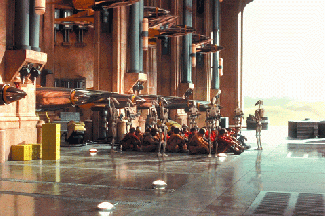
|
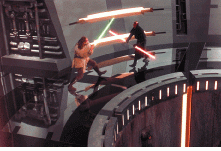 Only the people in these two images are real. The sets and the droid troopers
were modeled at Industrial Light & Magic.
Only the people in these two images are real. The sets and the droid troopers
were modeled at Industrial Light & Magic. |
 To help make the biggest fish in the undersea Gungan world look menacing,
the modeler sharpened its teeth and gave it tiny eyes.
To help make the biggest fish in the undersea Gungan world look menacing,
the modeler sharpened its teeth and gave it tiny eyes. |

|
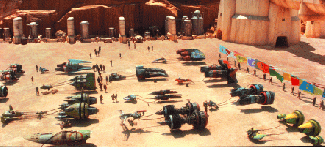 A few of the 18 pods, which are CG models when moving, are lined up (at
right) for the start of the race. The pod racers are always digital, although
that didn`t help the racer below get off the ground.
A few of the 18 pods, which are CG models when moving, are lined up (at
right) for the start of the race. The pod racers are always digital, although
that didn`t help the racer below get off the ground. |
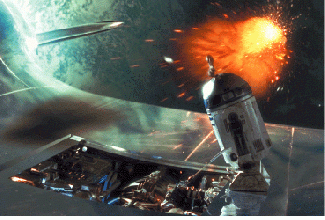
|
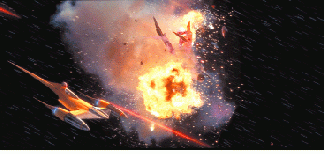 The queen`s ship and the Naboo N-1 Starfighter pictured were modeled using
techniques familiar to computer-aided industrial designers.
The queen`s ship and the Naboo N-1 Starfighter pictured were modeled using
techniques familiar to computer-aided industrial designers. |
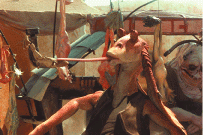
|
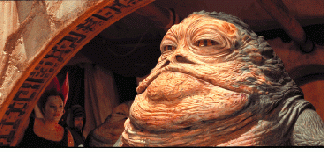 ILM modelers created special shapes for Jar Jar`s tongue, and carefully
folded the geometry in Jabba the Hutt`s model to create the folds in his
skin.
ILM modelers created special shapes for Jar Jar`s tongue, and carefully
folded the geometry in Jabba the Hutt`s model to create the folds in his
skin. |
| Good Moves |
| Some animators call it the devil`s rotoscope. Although
motion capture was used successfully for Titanic, it`s been the exception
rather than the rule for visual effects. At ILM, mocap was tested, but
not used for 101 Dalmatians; tried for Casper but used only for one shot
of Casper`s mouth, and also used in a quick shot for Spawn. Then Star Wars
Episode I made it viable to consider motion capture in a big way. "There
were so many scenes that needed a volume of animation," says Jeff Light,
who helped set up ILM`s motion-capture studio and became motion-capture
supervisor for Episode I. The studio now has a well-utilized Oxford Metrics`
20-camera Vicon 8 optical motion-capture system, from Vicon Motion Systems
(Tustin, CA). "We captured hundreds of performances," says Seth Rosenthal,
motion-capture supervisor for the studio. |
| For Star Wars, motion-capture data helped create animatics
(animated storyboards) for previsualization, became reference material
for keyframe animators, and provided animators with motion cycles they
could use for the Gungan soldiers and battle droids. To create the animatics,
Light acted out the entire film while wearing Ascension Technology`s (Burlington,
VT) wireless magnetic motion-capture system. Keyframe animators working
on Jar Jar had reference data captured from actor Ahmed Best, who wore
optical markers for the Vicon system, as did Light and James Tooley, who
performed the Gungans and droids respectively. "James and Jeff could perform
to the plate," says Rosenthal. "They knew clearly what the shots entailed
because they were responsible for them. We were able to do emergency shots
in the morning and see them in dailies a day or two later," he adds. |
| This animation efficiency was due in part to software ILM
developed. "I didn`t like motion capture any more than any animator would,"
Light says, "so I decided I`d [create a system] from an animator`s perspective."
As a result, when an animator gets motion data, it`s already applied to
the hierarchy of the character, so the animator can easily use all or any
part of it. |
| Now that Star Wars is over, ILM is using motion capture
for other projects. Already the motion-capture studio has bee Now that
Star Wars is over, ILM is using motion capture for other projects. Already
the motion-capture studio has been put into action for another movie, The
Mummy, and has helped design a creature for a game developer. |
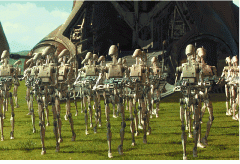 "Mocap" data helped animators move the droids.
"Mocap" data helped animators move the droids. |
Barbara Robertson is West Coast senior editor for Computer Graphics
World. |
|
Computer Graphics World July, 1999
|
 |
Copyright © 2001 - PennWell Corporation and PennNET, Inc. All rights
reserved.
|